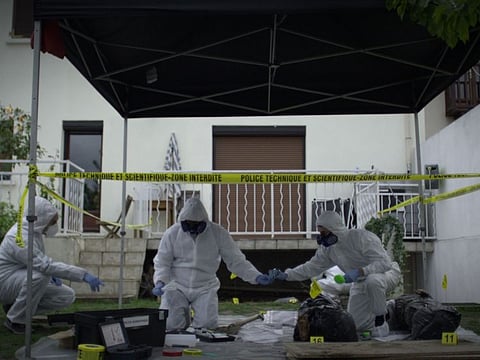‘Unsolved Mysteries’, popular in the ‘90s, is back to scare new generation
Series features stories of murders, disappearances and other creepy occurrences

If you were a child in the ‘80s or ‘90s — and maybe even if you were an adult — you probably lost a few nights’ sleep to ‘Unsolved Mysteries.’
Hosted by the leathery-voiced Robert Stack and featuring one of the eeriest theme songs in TV history, the long-running reality show scared the bejeezus out of a generation with stories about brutal murders and baffling disappearances, yeti sightings and alien abductions, medical mysteries and long-lost loves.
Airing for nine seasons on NBC and later moving to CBS and Lifetime, the programme was both well ahead of its time — inviting audiences to “help solve a mystery” as they would later via countless Reddit discussions and hit podcasts — and firmly of it, with dated re-enactments and low-fi special effects. Sometimes corny, often terrifying, ‘Unsolved Mysteries’ left a mark on pop culture.
Now, like so many other nostalgia-steeped properties from the 1990s, it’s being revived for the streaming era. Six new episodes of ‘Unsolved Mysteries’ premiered on Netflix, and another batch is slated for later this year.
The spooky theme song is back in a new arrangement, and the franchise has likewise been retooled to suit contemporary tastes: there’s no host, no narration and no more literal re-enactments. Each episode focuses on a single subject, allowing for a greater level of detail and nuance. Stylistically, the reboot — executive produced by Shawn Levy — shares as much DNA with ‘The Jinx’ or ‘Making a Murderer’ as the original ‘Unsolved Mysteries.’
Cross-generational appeal
“I have a sense of how we might captivate the young viewer of today, and that’s where our ambitions lie for this show: to satisfy fans of the original and to indoctrinate people who come to this with no history,” says Levy, likening it to his Netflix hit, ‘Stranger Things,’ in its cross-generational appeal.
Executive producer Terry Meurer says she and fellow co-creator John Cosgrove have wanted to bring ‘Unsolved Mysteries’ back ever since they stopped producing new material in the early 2000s. And she says that right now, at a moment when the internet has empowered amateur sleuths, is the ideal time for it.
“The fervent armchair detectives really like to dig into the details of these cases, and I think after they watch each episode they’ll go to Google. People are sophisticated, they’re hungry for more information and they want longer-form stories.”
But bringing the show to viewers accustomed to cinematic, long-form documentary storytelling — especially on Netflix — meant major updates to the format.
In-depth analysis
For starters, each episode of the revival goes in-depth on just a single case. “When we were doing the original episodes, it was challenging to take a very multidimensional mystery with lots of twists and turns and try and put it into 12 or 15 minutes. So we like the idea of being able to do a deeper dive into these episodes,” Meurer says.
The creative team ultimately decided to go without a host or narrator, partially an acknowledgement that it would be impossible to replace Stack, who died in 2003. “It is very hard to fill Robert Stack’s shoes,” Meurer says. “But we also wanted to give (our subjects) more of a chance to tell their own stories and to have them be the larger characters in the episodes.”
The re-enactments are still here, but they are now visceral, impressionistic and less literal, says Marcus A Clarke, who directed three of the six episodes.
Aesthetically, the revival may be quite different from the original, but viewers are likely to feel just as unsettled as they did back in Stack’s day. Levy chalks that up to what he describes as Meurer’s finely calibrated “creepometer.” “Her instincts for when to dial up the creepy factor” are excellent, he says.
The show still explores mysteries beyond murders and disappearances — yes, there’s a UFO episode — but some of the show’s original categories no longer make sense in the digital era.
Global audience
Producers also made a concerted effort to find cases that would appeal to — and could potentially be solved by — Netflix’s global audience.
“It is a more diverse set of stories, geographically, racially and above all tonally,” says Levy.
‘House of Terror’ tells the story of Xavier Dupont de Ligonnes, a French man from an aristocratic family who disappeared after his wife and four children were murdered. ‘Mystery on the Rooftop’ examines the suspicious case of Rey Rivera, who either jumped — or was pushed — to his death from the roof of a historic Baltimore hotel.
The timely episode ‘No Ride Home’ delves into a possible hate crime involving Alonzo Brooks, a Black man who vanished from a party in rural Kansas in 2004. His body was found on the property — which police had searched — a month later. The FBI recently reopened the case, offering a $100,000 reward for information.
Like many others, Clarke, who spent several tense weeks on location in Kansas filming the episode, said he believes race was a factor in Brooks’ death. “He is just one story of many African Americans who’ve been caught up in systematic racism,” he says.
The creative team behind the revival is confident the international reach of Netflix — 183 million subscribers and counting — and the ease of sharing information in the age of social media will bring resolution to some of these cases.
“I want this show to be entertaining,” says Levy, “but all the viewers in the world wouldn’t be as gratifying as one solved mystery.”
Don’t miss it!
‘Unsolved Mysteries’ is now streaming on Netflix.
Sign up for the Daily Briefing
Get the latest news and updates straight to your inbox








